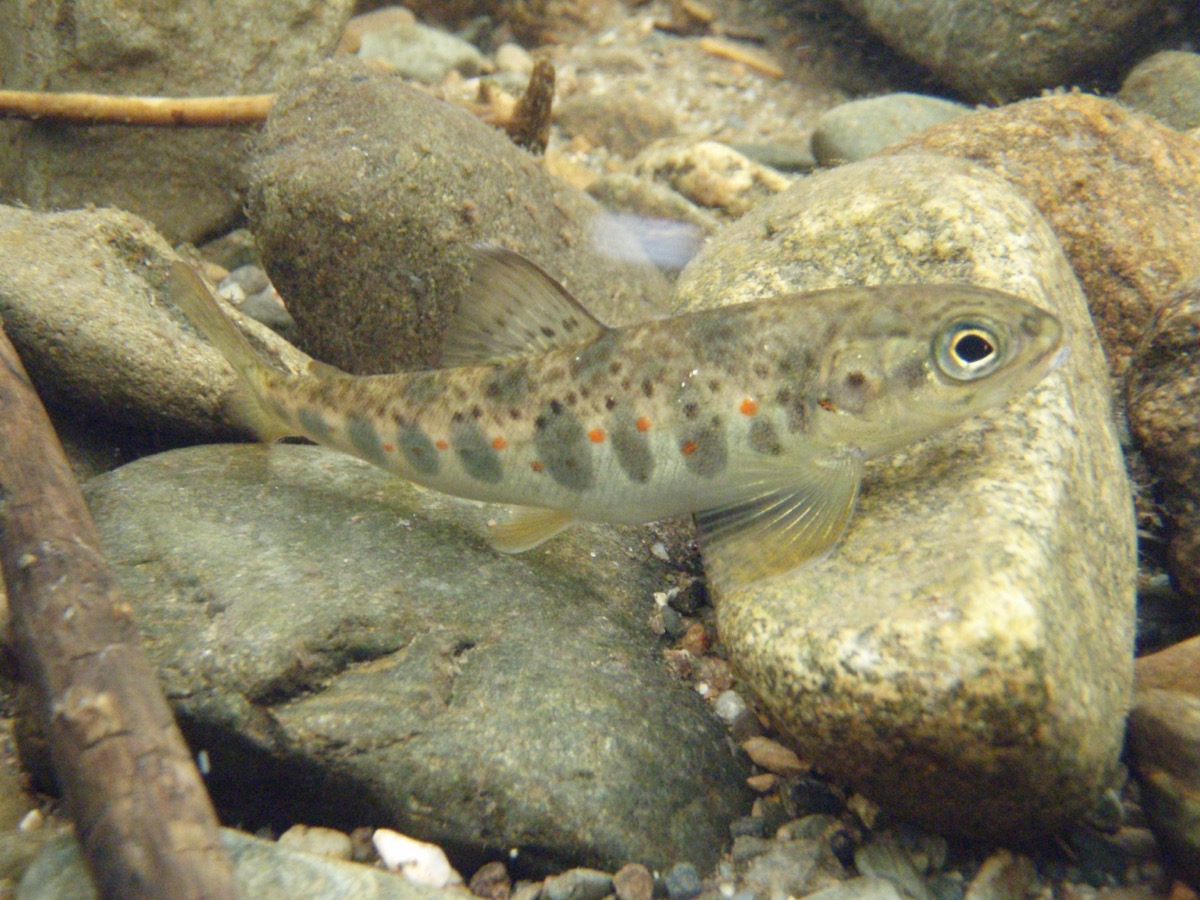Finding Home, Magnetically
9:49 minutes

To be a salmon is to live an adventurous life: They hatch in freshwater streams, travel miles downstream to the ocean, and live years dodging predators in the open sea. But in order to reproduce, they must return back to that mountain stream, however far away.
How do they find their way? And how do they know which stream, of all those emptying into the rivers that flow into the sea, is the one they were born in? Research in 2014 confirmed that Pacific salmon can sense and respond to the Earth’s magnetic field—and that’s at least one component of how they find their home river.

Now, a group of Atlantic salmon, descended from a group that’s spent 60 years in a landlocked lake, has also demonstrated this ability. Scientists writing in the Proceedings of the National Academy of Sciences describe that when exposed to an induced magnetic field mimicking the northern Pacific Ocean, juvenile salmon, reared in landlocked Oregon, will try to swim south. And when exposed to the magnetic field mimicking a point much further south, the same fish will try to swim north.
Lead author Michelle Scanlan, a faculty research assistant in the Department of Fisheries and Wildlife at Oregon State University, explains the implications of this behavior for both wild Atlantic salmon and in populations kept, as many are, in fish farms nationwide.
Michelle Scanlan is a Faculty Research Assistant in the Department of Fisheries and Wildlife at Oregon State University in Corvallis, Oregon.
IRA FLATOW: This is Science Friday. I’m Ira Flatow.
Every year, salmon go on the most important journey of their lives. After living years in the wild, wild oceans, they must swim back to the coasts to one very particular river mouth and then retrace miles of tributaries, branches upstream, until they finally arrive in the little freshwater spring where they were born. How did they do this?
Well, like any good trip, you need a map, and not just a compass that’s just telling you where north is. You also need to know the location of the place you’re going to get to. Is it straight north? Is it more northeast, east than south?
Well, a few years ago, researchers concluded what they had long suspected, that Pacific salmon can detect the magnetic field lines of the Earth. Their map is their magnetic. And what about their Atlantic-dwelling cousins? And when you let fish live in quiet landlocked lives, they live their whole lives for dozens of generations landlocked, what happens to that map?
Here to explain more is Michelle Scanlan, a faculty research assistant at Oregon State University in Corvallis. Welcome to Science Friday.
MICHELLE SCANLAN: Thank you for having me.
IRA FLATOW: I just said it, but salmon live impressive lives, right? They travel all that way. How many miles do their journeys take?
MICHELLE SCANLAN: It is pretty impressive, and their journeys can be hundreds or even thousands of miles to their oceanic foraging grounds.
IRA FLATOW: And they usually hatch in these tiny streams, miles inland, and they have to go back there.
MICHELLE SCANLAN: That’s correct.
IRA FLATOW: And they don’t just have to navigate upstream, they have to find the right stream to go. How did they do this? they don’t have a– well, maybe they do have a GPS of some sort in them?
MICHELLE SCANLAN: Yeah. Salmon have a diverse array of tools that they use in order to navigate. And so when they reach streams, they generally would use their sense of smell. But in terms of, say, oceanic journeys and voyages, they use something more broad scale. And in this term, we think they’re using magnetic maps and magnetic information.
IRA FLATOW: Now I know that your research is looking at a different group of salmon, the Atlantic salmon. What makes them so interesting to you?
MICHELLE SCANLAN: This was a rather interesting opportunity, because the Atlantic salmon that we use for this study are actually descendants of individuals that were transferred from a landlocked lake in Maine to a landlocked lake in Oregon over 60 years ago for recreational fishery.
So these fish have never had access to the Pacific Ocean and have never set fin outside of a lake or, in the instance of our fish, outside of a hatchery.
IRA FLATOW: And yet, you found that they still have these geomagnetic maps in them that they would have needed had they not been landlocked.
MICHELLE SCANLAN: That’s correct.
IRA FLATOW: And how are they able to retain these and why?
MICHELLE SCANLAN: That’s an interesting question. So salmon, when they use magnetic information, they can use different aspects of the magnetic field, especially for maps. And so the Earth’s magnetic field has a couple of different components. One is the strength of the magnetic field or also known as magnetic field intensity. And so those intensities are stronger at the poles and weaker at the equator.
Another aspect of the field that they can use is called inclination angle, and that’s the angle at which magnetic field lines intersect the surface of the Earth. And so they are steeper toward the poles and shallower at the equator. And both of these components are predictively variable across the surface of the globe.
So it’s super convenient because these gradients of intensity and inclination angles aren’t parallel. So they form a type of bi-coordinate grid over much of the Earth. And so animals can actually derive both latitudinal and longitudinal information from the magnetic field.
IRA FLATOW: Do they have little magnets in their bodies that can do that?
MICHELLE SCANLAN: So the mechanisms behind magnetoreception are still unclear, but one of the leading hypotheses is that salmon and other species have tiny chains of magnetite and that is an iron oxide mineral that has magnetic properties. And so these chains of magnetite are associated with nerve cells.
And the thought is that these chains can be pulled by the Earth strength magnetic fields. And so changes in both the field strength and/or the inclination angle can result in action potentials. So these magnetic structures are thought to be found in the nose and also the lateral lines, so along the sides of the body of a fish. But the magnetoreceptor itself is still elusive.
IRA FLATOW: Now, why is it important to you? Why does it matter that they can still detect these fields?
MICHELLE SCANLAN: Well, it’s a rather interesting question. So we wanted to know whether landlocked members of species that could go to the ocean retain the map sense, just a point of curiosity. And we also wanted to know if Atlantic salmon also possess this ability. It’s another group of individuals that possess magnetic maps out of diverse amounts of species.
But we also wanted to know what happens when you test animals in novel, sort of, magnetic environments. One, can they even detect a magnetic field? But two, can they actually differentiate between those fields? And three, how do they actually respond?
IRA FLATOW: Mm-hm. And so how did you go about testing these fish?
MICHELLE SCANLAN: So the eggs from the individuals at the lake in Oregon were transported to the Oregon Hatchery Research Center, where they were reared and subsequently tested. And so we tested these individuals using a series of magnetic coils.
And essentially, it’s a series of wooden frames that are wrapped in copper wire. And when you attach copper wires to an electrical power supply and crank electric current through the magnetic coil, a byproduct of that electricity is a magnetic field.
And the really cool part about our coils is that it allows us to alter the direction and also the amperage of current in order to allow us to simulate magnetic fields from almost anywhere on Earth.
IRA FLATOW: So what you’re doing– I know from my basic physics in grade school, if I take a magnetized object and put it next to some metal, it will magnetize the metal in a certain direction. So that sounds to me basically what you’re doing to the fish. You magnetize them, setting their magnetic structures up to know where they are in a certain direction.
MICHELLE SCANLAN: Yeah. So we’re presenting them with magnetic fields essentially that, hopefully, interact with what we think are these tiny chains of magnetite that somehow connect with the nerve cells.
IRA FLATOW: Right. And so how did the fish respond to this?
MICHELLE SCANLAN: So we evaluate the movement, fish movement, by centering the fish in the coil. So there is a platform with a bunch of testing arenas. We have one fish per arena. And then we have cameras that are mounted above those testing arenas to give us a bird’s eye view of the test subjects during the trials.
So what this means is that we are generating thousands of photos of our fish. And so we take photos, and we assess the position of the fish’s head relative to magnetic north.
IRA FLATOW: Wow. That’s terrific. And do you know how good the resolution they have is? I mean, just how accurate they can be to these magnetic fields?
MICHELLE SCANLAN: That is a question for future research. So we don’t know how fine or coarse scale the magnetic resolution of those maps is, yeah.
IRA FLATOW: So speaking of looking forward, what would you like to do? What kind of other experiments or equipment would you like to have to test these fish again?
MICHELLE SCANLAN: So we have a whole number of experiments that we have talked about over the years, but one of the experiments would be to actually look at magnetic resolution of those maps. So having a series of points, moving them closer and closer together and to see how fine or coarse scale their responses actually are.
IRA FLATOW: Mm-hm. So could you save endangered salmon, then, by knowing some more about them?
MICHELLE SCANLAN: I mean, it always helps to know more information about a species that you’re trying to conserve. Knowing how they’re making movement decisions would certainly be helpful and probably a tool in salmon conservation but certainly not the only thing that we can use to try to preserve them.
IRA FLATOW: Well, good luck to you in your future experiments.
MICHELLE SCANLAN: All right. Thank you very much.
IRA FLATOW: Michelle Scanlan is a faculty research assistant, Department of Fisheries and Wildlife at Oregon State University in Corvallis. And she was the lead researcher in an article appearing in the proceedings of the National Academy of Sciences.
Copyright © 2018 Science Friday Initiative. All rights reserved. Science Friday transcripts are produced on a tight deadline by 3Play Media. Fidelity to the original aired/published audio or video file might vary, and text might be updated or amended in the future. For the authoritative record of Science Friday’s programming, please visit the original aired/published recording. For terms of use and more information, visit our policies pages at http://www.sciencefriday.com/about/policies/
Christie Taylor was a producer for Science Friday. Her days involved diligent research, too many phone calls for an introvert, and asking scientists if they have any audio of that narwhal heartbeat.